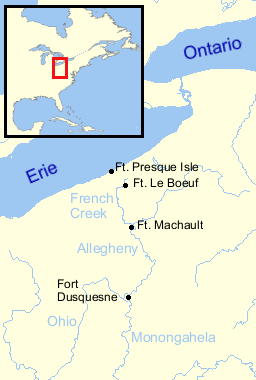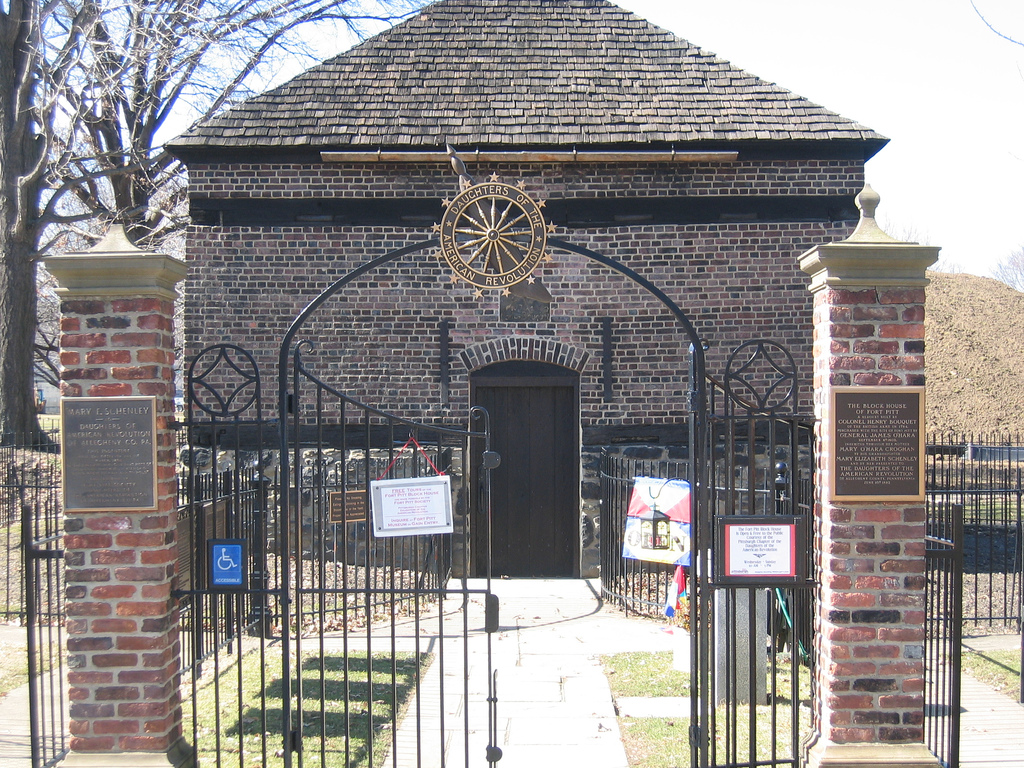The French and Indian War was the North American conflict that was part of a larger imperial conflict between Great Britain and France known as the Seven Years' War. The French and Indian War began in 1754 and ended with the Treaty of Paris in 1763. The war provided Great Britain enormous territorial gains in North America, but disputes over subsequent frontier policy and paying the war's expenses led to colonial discontent, and ultimately to the American revolution.
In North America, the war pitted France, French colonists, and their Native allies against Great Britain, the Anglo-American colonists, and the Iroquois Confederacy, which controlled most of upstate New York and parts of northern Pennsylvania.
A dispute over land
In 1753, Great Britain controlled the thirteen colonies from the Atlantic coast to the Appalachian Mountains. Beyond the mountains lay New France, a very large, sparsely settled colony that stretched from Louisiana through the Mississippi Valley and Great Lakes to Canada. The border between French and British possessions was not well defined, and colonists and officials of both countries tried to settle and control it.
One disputed territory was the upper Ohio River valley. Wanting to limit British influence along their frontier, the French built a string of forts from Lake Erie towards the forks of the Ohio (present-day Pittsburgh). Because rivers were so important to transportation, the forks of the Ohio was a strategically important location, one that both nations wanted to control.
Since the colony of Virginia also claimed this region, Virginian lieutenant governor Robert Dinwiddie sent Major George Washington with a small expedition to order the removal of the French forts in late 1753. Washington arrived at Fort Le Boeuf, about 15 miles inland from present-day Erie, Pennsylvania, and delivered his message. The commander of the fort, Jacques Legardeur de Saint-Pierre, received Washington and his men courteously, but denied the validity of English claims to the contested region. Washington returned to Virginia and delivered the French reply to Governor Dinwiddie.
Dinwiddie and the Virginia legislature agreed that French rejection of British demands was a hostile act, and that the French must be driven from their frontier forts. Dinwiddie sent Captain William Trent of the Virginia militia to build a fort at the forks of the Ohio River. Dinwiddie also promoted Washington to the rank of Lieutenant Colonel and ordered an expedition to compel the French to surrender their forts.
The war begins
At the same time, French and British officials worked to build alliances with American Indians living in the region. The most important group, the Mingoes, were part of the Iroquois Confederacy, which in turn was allied with Great Britain. British officials claimed that the Iroquois Confederacy had given an Indian named Tanaghrisson the title of "Half-King" over the Mingoes and other Native communities. But many Indians in the upper Ohio Valley were concerned about British colonists encroaching upon their land, and did not accept either British or Iroquois authority. Although many of them also feared French power and held grudges against the French from previous wars, the Indians of the upper Ohio valley saw a French alliance as the lesser of two evils. They agreed to supply French forces with additional men and information about British movements.
With the aid of the Mingoes, the French soon learned about the fort that Trent's small group of men were building. On April 17, 1754, French troops forced Trent to surrender and destroyed the unfinished fort, replacing it with a much larger fort of their own, Fort Duquesne (Doo-kane).
Further south, George Washington, accompanied by Tanaghrisson, surprised an encampment of French soldiers in southwestern Pennsylvania on May 24, 1754. A brief fight ensued, and afterwards the wounded French leader, ensign Joseph de Jumonville, tried to explain through translators that the French expedition was on a peaceful mission to warn British forces about their incursions into French-claimed territory. The two sides disputed what happened next, but it seems that Tanaghrisson, who bore an intense personal hatred of the French stemming from earlier war experiences, killed Jumonville. Expecting a French attack, Washington hastily constructed a fort and prepared to defend his forces, but a combined French and Indian force forced his surrender on July 3.
When he heard of Washington's defeat, Lieutenant-Governor Dinwiddie called for aid from neighboring colonies, but only North Carolina responded -- and refused to send any men or money outside its own borders. The British Prime Minister, the Duke of Newcastle, planned a quick strike against the French forts before they could be reinforced. But other British leaders wanted a bigger war, and so they publicly announced Newcastle's plans -- alerting the French, who sent additional armies to North America and worked to build alliances with other European nations. Once military forces were under way, war was inevitable.
A world war
What had begun as a skirmish on a distant frontier quickly became a world war, as the European powers fought in Europe, North America, the Caribbean, Asia, and the Pacific Islands.
The war did not begin well for the British. The British government sent General Edward Braddock to the colonies as commander in chief of British North American forces, but he alienated potential Indian allies, and colonial leaders didn't cooperate with him. On July 13, 1755, Braddock himself died on a failed expedition to capture Fort Duquesne. The war in North America settled into a stalemate for the next several years, while in Europe the French scored an important naval victory and captured the British possession of Minorca in the Mediterranean in 1756.
After 1757 the war began to turn in favor of Great Britain. British forces defeated French forces in India, and in 1759 British armies invaded and conquered Canada.
Facing defeat in North America and difficulties in Europe, the French Government attempted to engage the British in peace negotiations. But British Secretary of State William Pitt demanded that the French give up Canada and make concessions on trade, which France refused. To pressure Britain into a peace agreement, Spain threatened to join the war on the side of France. Britain, refusing to give up its demands, declared war on Spain in 1761.
British victory
In the end, the strength of the British navy and the ineffectiveness of the Spanish military led to a British victory. British forces seized French Caribbean islands, Spanish Cuba, and the Philippines. Fighting in Europe ended after Spanish forces invaded Portugal, a British ally, and were defeated. By 1763, French and Spanish diplomats began to seek peace. In the resulting Treaty of Paris, Great Britain gained all French territory east of the Mississippi river, as well as Spanish Florida.
Unfortunately for the British, the victory carried the seeds of future trouble with Great Britain's American colonies. The war had been enormously expensive, and the British government's attempts to impose taxes on colonists to help cover these expenses resulted in increasing colonial resentment of British attempts to expand imperial authority in the colonies. British attempts to limit western expansion by colonists and inadvertent provocation of a major Indian war further angered the British subjects living in the American colonies. These disputes would ultimately spur colonial rebellion that eventually developed into a full-scale war for independence.
Source Citations:
"French and Indian War/Seven Years' War, 1754-63." n.d. Office of the Historian. U.S. Department of State. https://history.state.gov/milestones/1750-1775/french-indian-war.
"Incidents leading up to the French and Indian War, 1753-54." n.d. Office of the Historian. U.S. Department of State. https://history.state.gov/milestones/1750-1775/incidents

